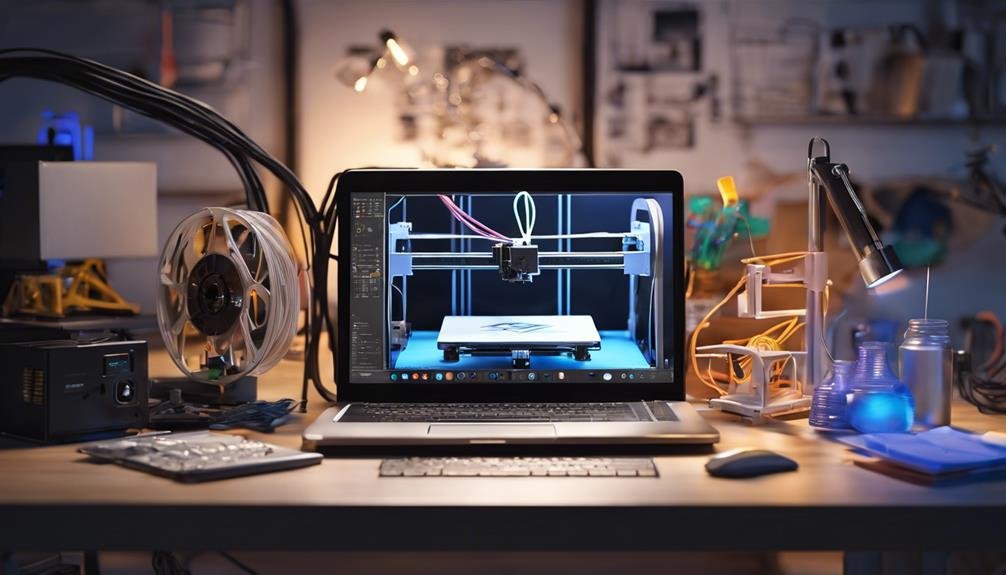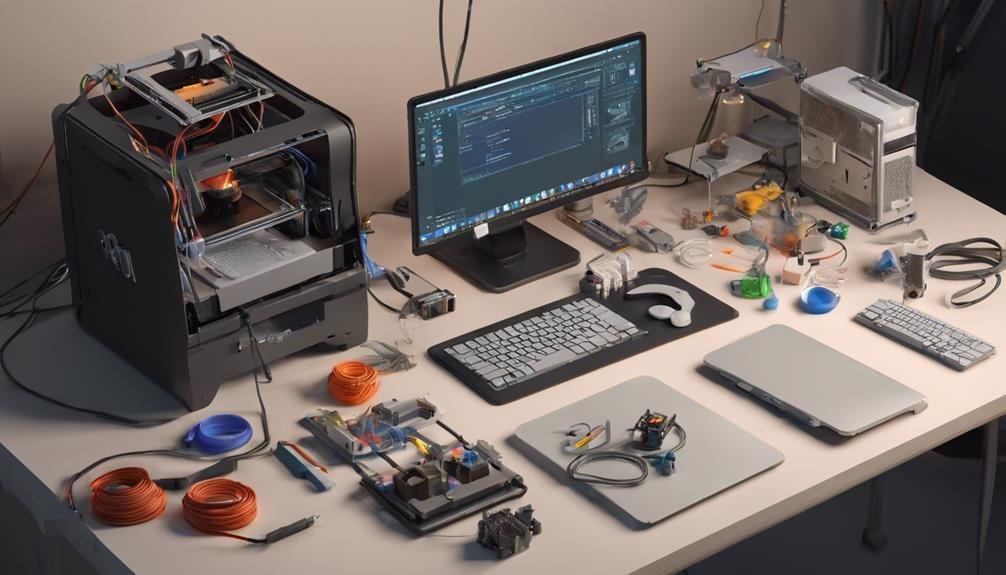When purchasing a 3D printer, you might wonder if a computer is necessary, and the answer depends on the printer type. Tethered printers require a computer connection for control, whereas untethered ones offer more freedom and autonomy. For tethered printers, your computer's performance affects the printing experience, allowing real-time monitoring and adjustments. You'll need a computer with at least 8GB RAM, a 4-core processor, and 512GB storage for basic tasks. Depending on your printer and printing needs, you may need a more powerful computer. As you delve into the world of 3D printing, you'll find there's more to uncover about the intricate relationship between computers and printers.
Types of 3D Printers and Computers
In the domain of 3D printing, you're likely to encounter two primary categories of printers: tethered and untethered models, each with its unique characteristics, advantages, and suitability for different users and applications.
As a beginner, you'll likely opt for a tethered printer, which relies on a computer connection for control and operation. This means your computer's performance and stability will directly impact your printing experience. You'll need to make sure your PC can handle the demands of 3D printing software, including slicer software that converts your designs into printable layers.
With a tethered printer, you'll need to keep your computer on and connected to the printer throughout the printing process. This can be beneficial for complex models, as you can monitor and adjust the printing process in real-time. However, this setup may limit your printer's mobility and require more maintenance.
Computer Requirements for 3D Printing
To ensure a seamless 3D printing experience, you'll need a computer that meets specific requirements, as the appropriate hardware can greatly impact the quality of your prints. For basic 3D printing tasks, a computer with 8GB of RAM, a 4-core processor, 512GB storage, and no dedicated graphics card is sufficient.
However, more advanced 3D modeling and printing may require a computer with 16GB of RAM, a 6-core processor, at least 1TB storage, and a graphics card like NVIDIA 1650ti or better.
Using a laptop for 3D printing is suitable for basic operations, but may not handle intensive 3D modeling tasks efficiently. A good computer for 3D printing should have a Windows operating system for compatibility with 3D printing software and hardware.
The computer's specifications play an essential role in both designing 3D models and ensuring proper printing settings for successful 3D prints. A slicer program, which converts 3D models into printable layers, also relies on the computer's processing power.
With the right computer requirements, you'll be able to efficiently design and print high-quality 3D models.
Role of Computers in 3D Printing

You'll find that computers play an essential role in 3D printing, as they're responsible for preparing 3D printable files and converting designs to G-code using slicer software.
When it pertains to designing 3D models, the computer you need will heavily rely on software on your PC to handle 3D modeling tasks. These tasks require significant processing power, especially for complex designs. You'll need to take into account the computer's specs, as basic 3D printing may only require 8GB RAM and a 4-core processor, but more demanding tasks may need 16GB RAM and a 6-core processor.
Laptops can be suitable for basic operations, but may not be ideal for intensive 3D modeling due to potential overheating.
In both designing and printing processes, computers are indispensable tools for a successful 3D printing operation. They enable you to set proper printing parameters, ensuring a smooth 3D printing operation.
Slicing Software for 3D Models
Your computer relies on slicing software to convert 3D models into printable instructions, an important step in preparing your designs for the 3D printer. This software is vital in breaking down the complex 3D models into layer-by-layer instructions that the printer can understand.
Popular slicing software like Cura, PrusaSlicer, and ChiTuBox Basic are designed to handle this task efficiently. When you import your 3D model into the slicing software, it uses your computer's processing power to slice the model into individual layers. This process can be computationally intensive, which is why a decent computer is necessary.
The software then generates G-code, a file format that the printer can read, and saves it to an SD card or transfers it to the printer via USB. The standard file format for 3D models, .stl files, is widely supported by slicing software, making it easy to prepare your designs for printing.
Transferring Files to 3D Printers

Once your slicing software has generated the G-code instructions, it's time to transfer them to your 3D printer for actual printing.
You can easily transfer these files to your printer using an SD card, which eliminates the need for a continuous computer connection. This means you don't require a computer to be present during the printing process, as the 3D printer has an onboard computer that can operate standalone.
Here are some ways you can transfer files to your 3D printer:
- Use an SD card to transfer the G-code files directly to the printer
- Download 3D models from websites like Thingiverse.com and transfer them to the printer for printing
- Use your laptops tend to transfer files to the printer, but you won't even need to keep the laptop connected during printing
Since the actual printing process doesn't require a computer, you can simply transfer the files and let the printer do its job. You won't need to constantly monitor the computer screen or keep your laptop connected, making the process more convenient and hassle-free.
Upgrading Your Computer for 3D
To take your 3D printing experience to the next level, upgrading your computer's capabilities can greatly improve performance and efficiency. You can start by increasing your RAM capacity, which will allow you to process complex 3D models more smoothly in CAD software and modeling software.
A faster CPU will also enable you to slice 3D models more quickly in slicer software, saving you time and effort. Moreover, a powerful graphics card can markedly boost the rendering of intricate 3D models, making it easier to visualize and edit them.
If you're using a desktop PC, consider upgrading to an SSD storage, which will reduce loading times for large 3D printing files and software. To top it off, investing in a high-resolution monitor can further enrich your visualization and editing experience, allowing you to see every detail of your 3D models.
Do You Need a Dedicated PC

When you start exploring the world of 3D printing, a question that often arises is whether you need a dedicated PC to get the job done. The good news is that you don't necessarily need a powerful computer to use with your 3D printer. Many 3D printers can operate independently, using onboard controls or standalone functionality. However, a computer is typically needed for designing and preparing 3D models, and for running popular slicer software.
Here are some scenarios where a dedicated PC might be necessary:
- You're working with complex 3D models that require advanced software and processing power.
- You plan to use your PC for other purposes, such as video editing or gaming, that require a high-performance computer.
- You want to upgrade your 3D printing setup in the future and need a PC that can handle more advanced tasks.
In general, beginners can start with a basic computer setup for 3D printing and upgrade as needed for more complex tasks. The necessity of a dedicated PC for 3D printing depends on the complexity of the models, the software used, and personal preferences.
Frequently Asked Questions
Do You Need a Computer for 3D Printing?
You'll likely need a computer for 3D printing, as it helps you customize settings like printer cost, printing speed, filament type, layer resolution, and print quality, and also enables network connectivity for seamless printing.
Can You Use a 3D Printer With a Phone?
You can easily use a 3D printer with your phone, leveraging mobile printing, cloud connectivity, and phone apps like OctoPrint for remote monitoring and wireless printing, even enjoying a touchscreen interface for seamless control.
What Do I Need to Run a 3D Printer?
To run a 3d printer, you'll need power supplies, different filament types, a build platform, a heated bed, and proper extruder calibration, in addition to deciding on layer thickness to guarantee a successful print.
Do You Need a Computer to Use a Printer?
You don't necessarily need a computer to use a 3D printer, but having one helps with printer software updates, meeting computer requirements, and ensuring device compatibility, making printing processes smoother with a user-friendly interface, even leveraging machine learning.
Conclusion
Now that you've delved into the world of 3D printing and computers, you know that a dedicated PC isn't always necessary, but it can significantly enhance your printing experience. With a suitable computer, you can enhance your prints, utilize advanced slicing software, and enjoy seamless file transfers.
By upgrading your computer or selecting the right one, you'll unleash the full potential of your 3D printer and elevate your creations to the next level.